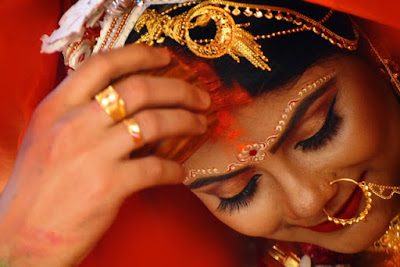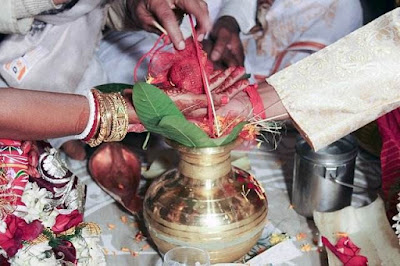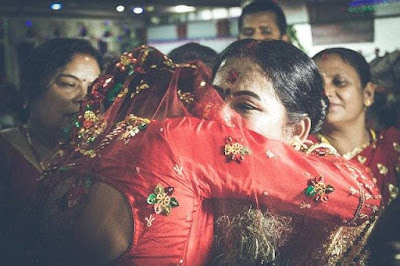A Bengali wedding is all about colorful rituals and great food. It focuses on completing all the rituals with precision. Each of these visually attractive elaborate rituals has a significance. Surely, it is not about a pompous show prevalent in north India. A traditional Bengali wedding is a four-day affair and starts from the day before the wedding.
 |
| Bengali Wedding Rituals |
Bengali Marriage Rituals
Ashirwad Or Paka Kotha
On an auspicious date, elder members from the bride’s family visit the groom’s place for the final discussion on the marriage. They give blessings to the groom by sprinkling trefoil and husked rice on his head.
Aiburo Bhaat
This ritual is all about enjoying the last meal as a bachelor or bachelorette. The close relatives or friends of the bride and groom arrange the sumptuous meals for them.
The best part about Aaiburo Bhaat is the number of dishes served to them. The food includes mouth-watering Bengali delicacies of their choice.
Gaye Holud
A Bengali wedding starts with this ceremony. It takes place before the wedding day. In some cultures, this also takes place on the morning of the wedding day. Both sides do this ritual. Seven married women of the household grind turmeric with Batan stone(Shil Nora) and anoint the couple with turmeric paste. 
 |
| Shop Here |
Also Read: Visit The Best Saree Shops In Kolkata For Most Elegant Drapes
Tattva
On the day of Gaye Holud, the groom’s family brings the turmeric paste, gifts for the bride and her family members. These gifts decorated with colorful papers are collectively called Tattva. It includes fish, various types of sweets, cosmetics, and clothes for the couple and their near family members.
Dodhi Mongol
On the morning of the wedding day, five or seven married women soak the bangles made with conch shells in turmeric mixed water. Then the bride is adorned with these bangles called Shakha and Pola. These bangles gifted by her mother form an integral part of her wedding trousseau.
 |
| Buy Here: Shakha Pola |
Next, she consumes a curd meal, after which the bride and her parents fast for the day till the wedding ceremony is over.
Nandi Mukh Or Vridhi Puja
The priest performs a Puja dedicated to the seven ancestral generations(Saat Purush) of the bride and groom to appease their souls and seek their blessings, along with Lord Narayan.
Gaach Kouto And Kajal Lata
A Bengali bride carries the gaach kouto and the kajal lata throughout the wedding day. People believe that Kajal Lata keeps the bride safe from negative energies and evil spirits.
 |
| Shop Here |
The bride holds this from the day of the marriage ceremony till she enters the house of her in-laws after the wedding.
Main Wedding Rituals
Bor Jatri
Family members and friends accompany the groom to the venue where the marriage takes place. He reaches the location in a car decorated with flowers. Groom’s mother does not attend the marriage ceremony. Read here the reason why the mother is not allowed in Son’s wedding.
Bor Boron
The mother and relatives of the bride come out to greet the groom and his family. A boron dala is prepared for the welcoming of the groom. In a bamboo winnow, an earthen lamp, trefoil, and rice are kept.
Ashirbaad
The elders from the bride’s side take their turns in blessing the groom and presenting him with gifts such as jewelry and even watches. The elders accompanying the groom repeats the same procedure with the bride. They bless her and gift her with pieces of jewelry.
Potto Bastra
The groom is taken to the altar or Chhadnatala (mandapa). All the wedding rituals are performed there. The elder member of the bride’s family presents cloth to the groom that he wears for the marriage rituals.
Saat Paak
It is one of the most exciting rituals in a Bengali marriage. Here the bride sits on a wooden tool named Piri. Her brothers lift the Piri while she sits on it and takes seven rounds around the groom on the altar. Meanwhile, the bride covers her face with two betel leaves and cannot see the groom.
Subho Drishti
In this fascinating ritual, the bride removes the betel leaves from the front of her face. She then looks at the groom, and both establish eye contact.
Mala Badal
After Subho Drishti, the bride and groom exchange floral garlands with each other thrice.
Sampradan / Kanyadan
After the Kanyadan ritual, the couple now sits side by side, the bride on the left.
Yagna/Hom
The couple sits in front of the sacred fire and recites special chants after the priest. The Yagna is aimed at pleasing the gods and goddesses to get their blessings for the newlywed.
Saptapadi
In Hindu weddings, the couple taking seven rounds around the fire(Phere) called Saptapadi. In a Bengali wedding, the bride and the groom touch seven suparis kept on seven Betel leaves laid out in a sequence with their toes. As they move forward, the groom moves the stone called Nora (typically used for crushing and pasting spices) with his foot.
Anjali / Kusumdinge
In this ritual, the couple offers puffed rice to the fire of the yagna. The bride’s brother puts puffed rice (Khoi) in the winnow hold by the bride. The groom will hold her hands from the back, and they together pour the puffed rice into the fire.
Sindoor Daan
Sindoor Daan finally brings the wedding ceremonies to an end. In this ritual, the groom puts Sindoor on the bride’s parting of hair without looking at her. The elders of the family help the bride to cover her head with a new saree. Groom’s mother gift this saree called Ghomta or Lojja Bostro.
The bride’s mother does not watch the wedding rituals.
Post Wedding Ritual
Bashor Ghar
After the marriage is complete, the newlywed couple, their young cousins, and friends get together for a fun talent face-off. They sing, talk, dance, and enjoy their hearts out.
Bashi Biye
This ritual is usually followed by the people, those who have roots in East Bengal.
The next morning, after sunrise, the newlywed couple go back to the altar. Here, the couple offers prayers and salutation to the Sun in the presence of the priest.
Bidaay
The farewell of the bride from her family is an emotional and heart-wrenching moment. All the elders gather together in the bride’s home and shower their blessings on the couple. The teary-eyed family bids her farewell and escorts her to the groom’s car. From there, she embarks on a new journey towards her new home.
Bodhu Boron
The groom’s mother welcomes the bride at her new abode by performing aarti. She then touches her mouth and ears with honey. The reason behind this ritual is that the mother-in-law expects the bride to only hear and talk about sweet things.
Water is poured under the vehicle. At the door, the bride then steps into a vessel containing Alta (lac dye) and milk and enters the new house leaving colorful footprints on the white fabric. When she enters her new household for the first time, she is welcomed by showing an alive fish(Magur Maach) and a boiling bowl of milk. It symbolizes good luck and prosperity.
The mother in law usually gifts the bride with a bangle made of iron plastered with gold called Loha Badhano. The groom helps the bride to wear this bangle. In some cultures, this ceremony happens during the wedding.
Bhaat Kapor/Ghee Bhaat
Bhaat Kapor in Bengali wedding is an important custom where the groom hands over a tray containing a new saree, Sindoor, a plate full of food to his wife. He promises in front of everyone to take responsibility for her food and clothing for the rest of her life.
Kaal Ratri
Kaalratri is the night after the marriage day. Both the bride and groom sleep separately. It is like the final moments of singlehood, and they accept to start a new relationship.
As per Indian mythology, the daughter of Lord Shiva, Manasa, was the Goddess of Snakes. She had asked Chand Saudagar, a wealthy merchant, to worship her as a deity. On his refusal, she had cursed him that all his sons will die. His youngest son Lakhindar got married to Behula. But the curse followed. He got bitten by the serpent and passed away on the night after their marriage. Behula prayed to Manasa to restore her husband to life. Manasa agreed, and Chand Saudagar started worshipping the snake Goddess.
Henceforth, the bride and the groom are forbidden to meet each other on this night.
Bou Bhaat
Phool Sojja
It is the first night when the couple is officially allowed to spend the night together as husband and wife. Their bedroom is decorated with flowers.
Ashtamangala
After eight days, the bride returns home to her place along with her husband. The newly wedded couple stay there for three days. A Satyanarayan puja is performed. The priest removes the thread tied on their hands during the wedding. This is the last ritual of a traditional Bengali wedding.









